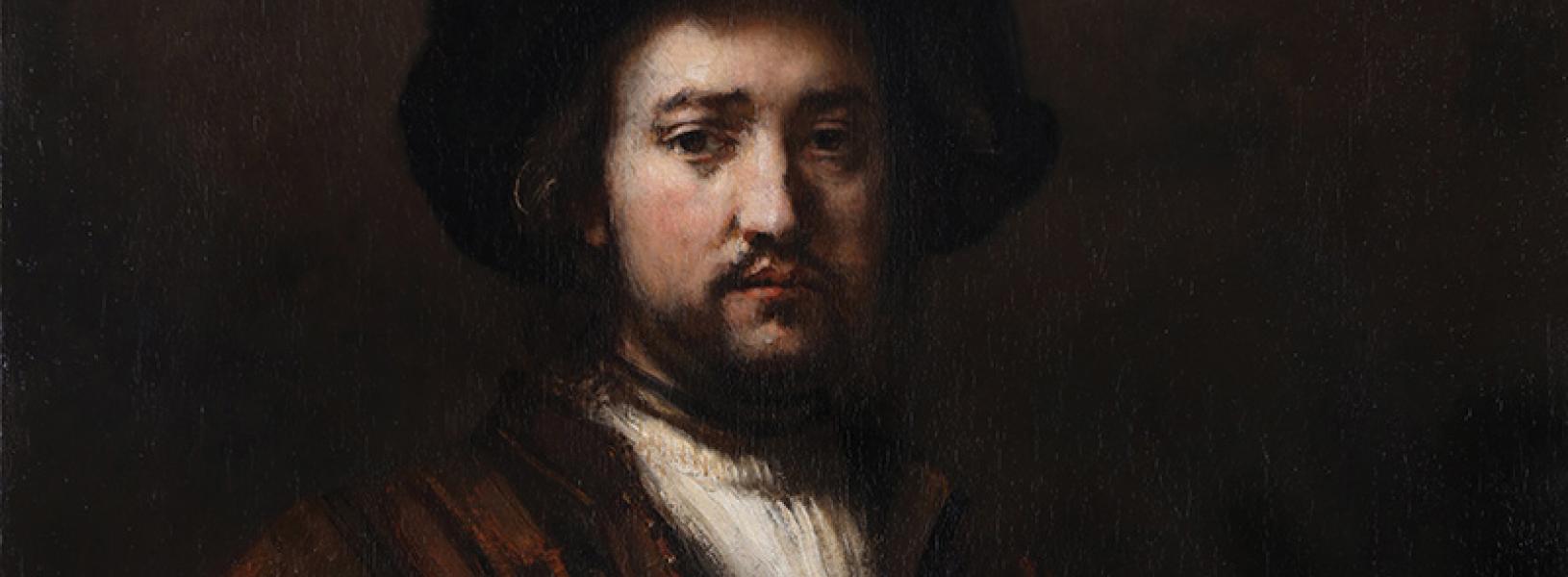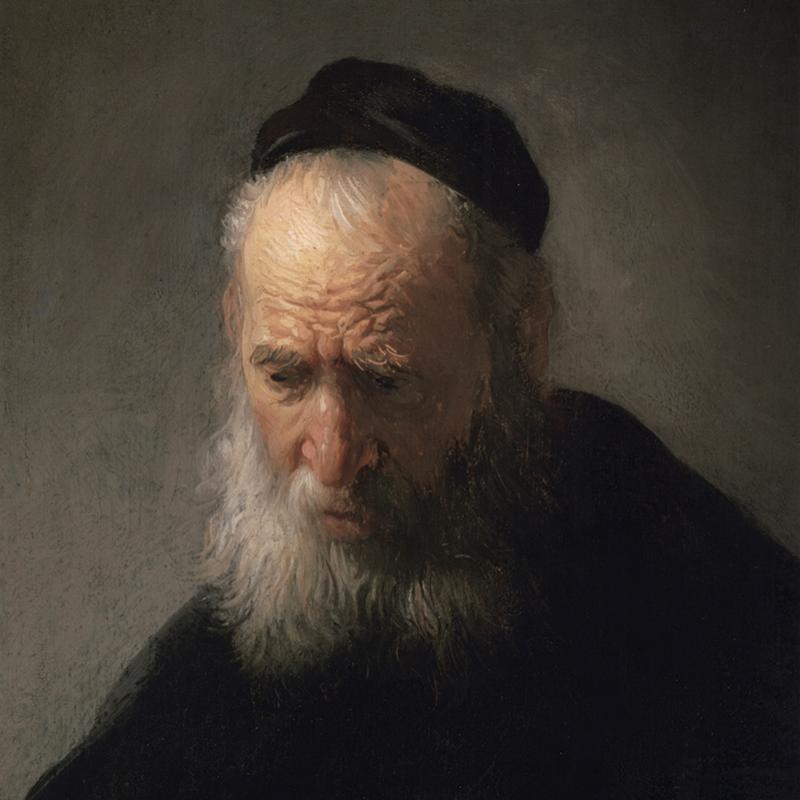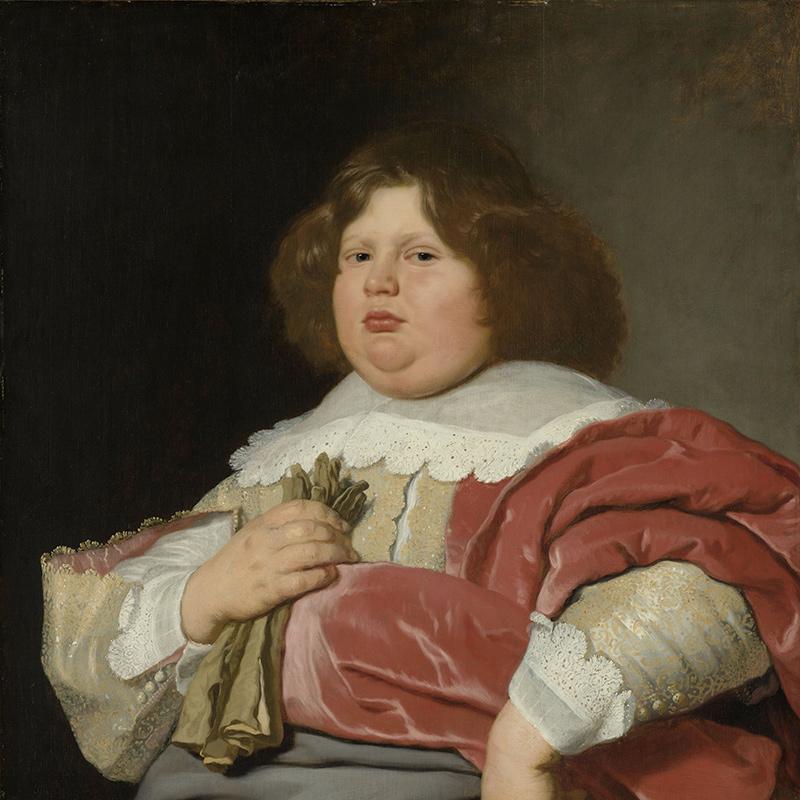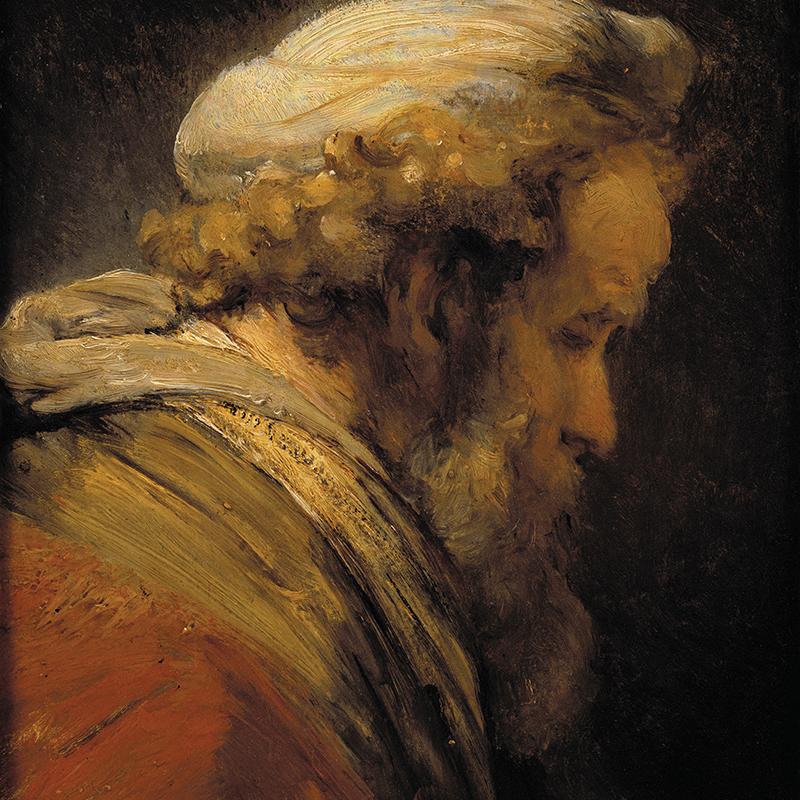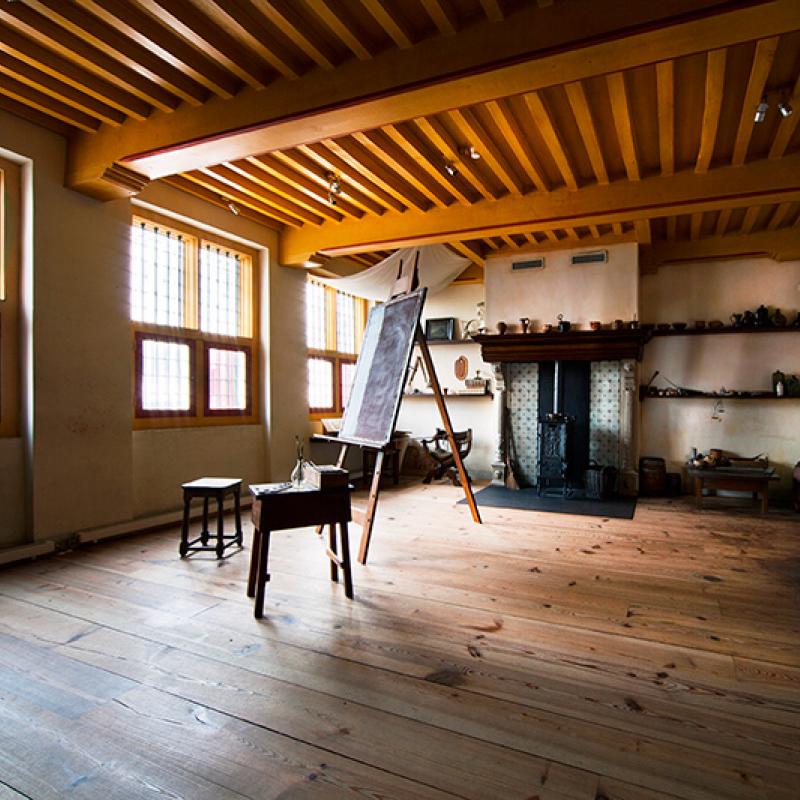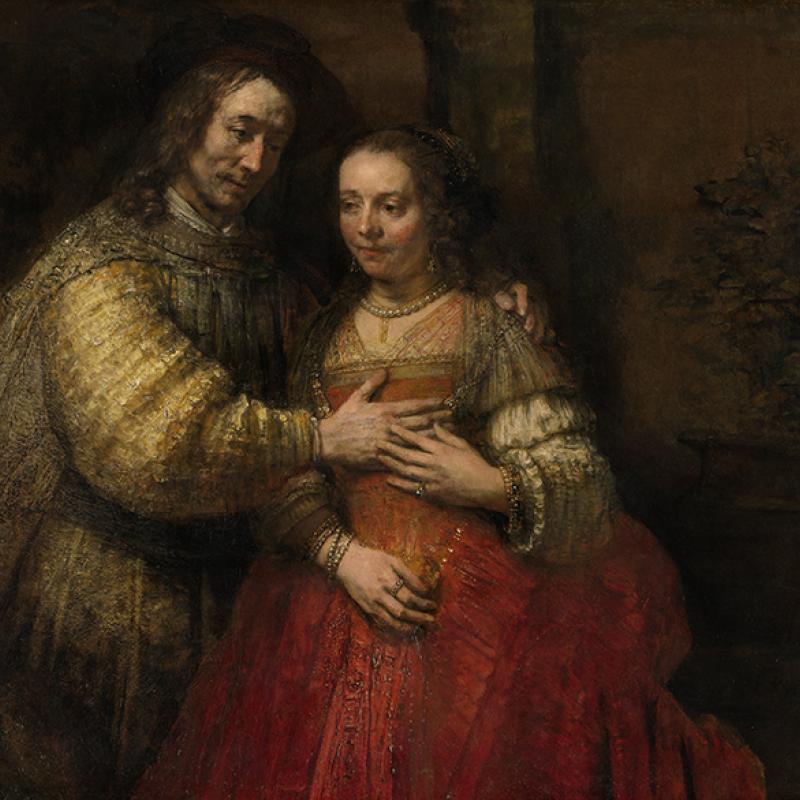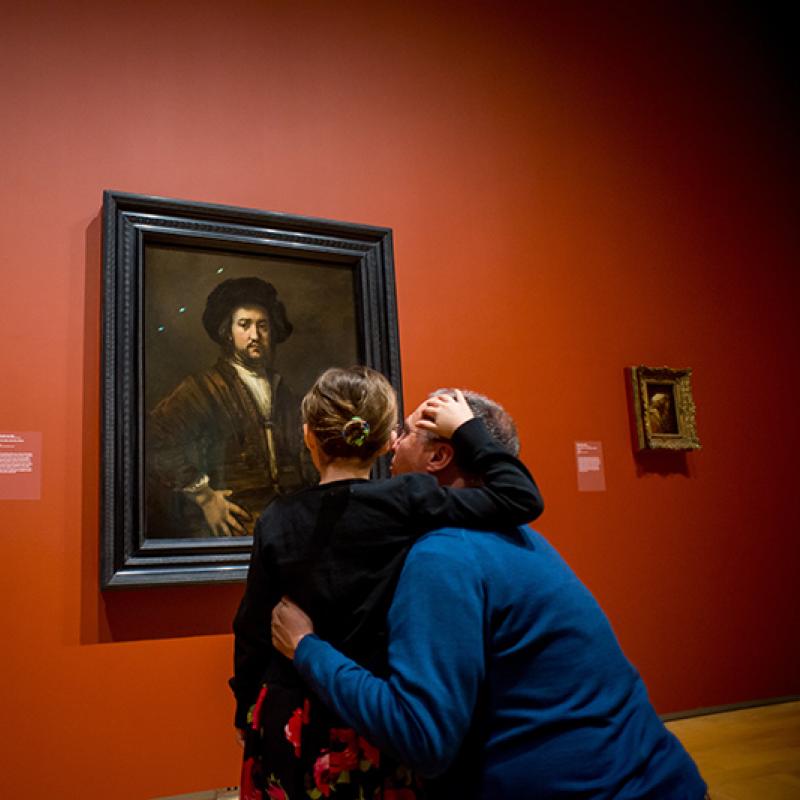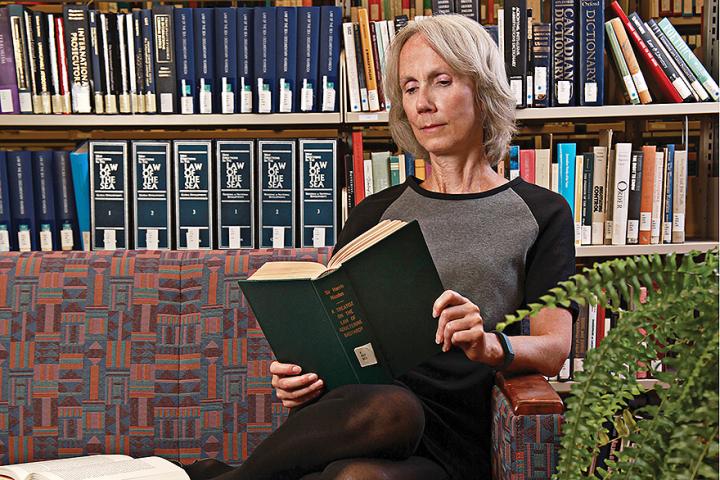Rembrandt van Rijn’s Portrait of a Man with Arms Akimbo dazzles in countless ways. The robust sense of presence and the life-size scale command the viewer’s attention. The provenance includes a roster of knowledgeable connoisseurs that attests to the painting’s longstanding reputation. But the work truly surpasses expectation as a masterful adventure in colour. The creamy richness of the man’s plaited chemise is a symphony of white, butterscotch and grey, while his stiff doublet sings in crimson, sienna and ochre. Tones from apricot to eggshell to carnation pink capture the warmth of his flesh. With a relatively limited range, Rembrandt has constructed a majestic tapestry of hues upon the canvas.
With a relatively limited range, Rembrandt has constructed a majestic tapestry of hues upon the canvas.
The colour harmonies in this portrait evoke the brilliant subtlety for which writers praised the artist. His contemporary Joachim von Sandrart (1606 –1688), a German painter who worked for the Amsterdam elite around 1640 (and thus competed with Rembrandt for commissions), had little praise for his colleague. Sandrart wrote with clear disdain, in the 1670s, that Rembrandt was not sufficiently familiar with the antiquities of Rome nor with art theory, and that he contented himself to be “guided by Nature alone.”
Painterly rivalry aside, Sandrart mustered up some admiration for Rembrandt’s use of colour, highlighting the way his Dutch counterpart “imitate[d] colours most intelligently and artistically” and manipulated them convincingly to suggest three-dimensional form on a two-dimensional support. The German painter evokes a wonderful visual metaphor in his invocation of other artists who place “coarse” colours quite brazenly next to one another so that they less effectively capture the visible world and more “resemble the colour oxes you see in shops or the cloths brought from dyers.”
The Italian biographer Filippo Baldinucci (1624 – 1697) noted that Rembrandt had achieved great prestige for his colouring and could have earned more commissions for portraits because of it, had he not laboured so much on each work.
A fall out of favour
As intimated in these commentaries, Rembrandt was no longer the most coveted portrait painter in Amsterdam at the time he executed this painting. By 1658, he had ceded that position to artists like Bartholomeus van der Helst and his former students Govert Flinck and Ferdinand Bol.
These artists employed blended brushstrokes, light tonalities, and even illumination in the manner of the great Flemish court artist Anthony van Dyck. This style had been termed “more enduring” than Rembrandt’s in a biography penned by an early writer.
The same author pithily asserted that “young women in particular took more pleasure in white than brown,” maintaining that the exuberance of clear lighting and elegant colours in a portrait will flatter in a way that Rembrandt’s shadowy figures could not.
Rembrandt seems to have felt the effect of this shift in taste: his portrait production decreased in the 1640s and early 1650s. But this must have had other causes beyond this competing style. After his arrival in Amsterdam around 1631, he worked for the dealer Hendrick van Uylenburgh as the featured portraitist in his atelier. Uylenburgh had secured a steady stream of commissions for the promising painter between 1631 and 1635 (when Rembrandt left the atelier and founded his own studio) and he contributed in a fundamental way to the young artist’s reputation in Amsterdam. Without Uylenburgh’s support, Rembrandt could not help but see fewer portrait commissions.
A focus on intellectual endeavours
The artist also concentrated more fully on the most esteemed genre of painting for a 17th-century artist, that of Biblical, historical and mythological subjects.
While portraits offered a steady form of income for painters, they also invoked one of the most contentious points in the dialogue surrounding painting, that of the imitation of the visible world. Portraits inherently demanded a close copying of the human face, which granted artists little possibility of demonstrating their creative potential.
Narrative or history painting, in contrast, called upon the artist’s invention to interpret and visualize movement, facial expression, environment and costume. Consulting the relevant textual and visual sources and working after models certainly assisted the artist in laying out the scene, but ultimately, it was his or her own imagination that determined the success of the staged scene. Whereas portraiture was disparaged by some as “slavish” copying, history painting was a thoroughly intellectual endeavour.
Finally, it seems that the character of Rembrandt’s patronage shifted from wealthy merchants to a more intimate group of connoisseurs who appreciated his mature style.
In the early 1650s, collectors like Jan Six gravitated toward the artist’s distinctive manner of depicting his sitters against a dark background from which they boldly emerge, executed with a wide brush loaded with myriad colours. The sometimes highly textured brushstrokes achieve convincing plasticity when viewed from a distance of several feet. This ruwe (rough) style, described beautifully by Baldinucci as “without contour or definition by means of inner and outer lines, but consist[ing] entirely of violent and repeated strokes,…” differed greatly from his earlier style in which small, distinctly coloured strokes of paint are applied with great precision.
Given their refined detail, these early paintings are more illuminating when seen up close. As theorists and painters wrote throughout the 17th century, the nette (neat) style of painting was better learned first in order to achieve proficiency in painterly form and compositional principles.
The ruwe style, in contrast, was the accomplished end product of a lengthy practice. It demanded more of the artist, for not only did it require that the artist have a firm understanding of how to use paint in an astute way,it called attention to his interpretative hand.
At times, the strength of the rough style forced a competition between the presence of the artist and the presence of the subject. It also took a sophisticated viewer to admire this style, for it necessitated imagination enough to complete the parts of the image that were left less defined. It is only natural that as Rembrandt’s style grew bolder, his following would comprise an elite group of connoisseurs.
Personal adversity
Scholars have long wondered to what degree the dramatic events in Rembrandt’s personal life may have affected his patronage in the mid- to late 1650s.
After the death of his wife, Saskia, in 1642, Rembrandt took on two lovers successively, his son’s former wet nurse Geertje Dircx and his housekeeper turned common-law wife Hendrickje Stoffels.
The affair with Geertje ended poorly in 1649. She and Rembrandt had worked out financial arrangements for their separation but, after a few months, she had determined that she was being insufficiently compensated and decided to sue Rembrandt for breach of promise to marry. Increasingly unruly behaviour led to her imprisonment in a house of correction later in the year. She would win her freedom and return to Amsterdam to seek further compensation in 1655.
This followed on the heels of Hendrickje’s confrontation with the Reformed Church in July 1654, when she admitted that she had “lived with the painter Rembrandt like a whore” and was banned from taking Holy Communion. Likely prevented by stipulations in Saskia’s will from marrying Hendrickje, Rembrandt may have suffered censure from some members of Amsterdam society that would have affected his commissions.
The other major challenge to the artist’s reputation around this time was his declaration of bankruptcy in 1656. His ruinous financial situation resulted from poor management of his money and external circumstances. In 1639, Rembrandt purchased a stately house on the Sint-Antoniebreestraat that would not only attest to his social ambitions but would also accommodate his active studio. The extravagant price of this house was a major source of his problems, for the artist had to borrow almost 70 per cent of the principal (13,000 guilders).
Irresponsible handling of this debt resulted in a string of negotiations with creditors in the early years of the decade, ending in a declaration of cessio bonorum in July 1656. This type of insolvency required that the artist cede his assets to his creditors in exchange for a release from further claims. Though this form of financial failure was relatively generous – the artist was neither jailed nor exiled from the city – it still resulted in the auction of his substantial art collection and his grand home in 1658, precisely the year in which Portrait of a Man with Arms Akimbo was painted. Even his obsessive collecting of prints, paintings, sculptures, curios and medals, which served as important sources of inspiration, likely contributed to his financial decline.
Outside of Rembrandt’s specific circumstances, the First Anglo-Dutch War (1652 – 1654) not only depressed the Dutch economy but may have also affected Rembrandt’s investments. Such an experience could not have been anything short of distressing for the enterprising artist.
Yet Rembrandt was far from defeated. After 1658, he would paint some of his most riveting portraits, including those of the Drapers’ Guild of Amsterdam in 1662, the painter and theorist Gerard de Lairesse around 1665, and a portrait of a couple as Isaac and Rebecca (The Jewish Bride) in 1665.
He was invited to participate in a number of prominent projects, including a large painting for the gallery of the new Town Hall of Amsterdam, one of the leading artistic and architectural projects of the Dutch Republic in the 17th century, as well as an altarpiece for a lavish basilica in Genoa.
In December 1667, Rembrandt even received a visit from the Cosimo III (1642 – 1723), the future archduke of Tuscany.
The man in the portrait
Given that Rembrandt had received an important commission from a Sicilian collector as early as 1652, the head of the Rembrandt Research Project, Ernst van de Wetering, has conjectured that the swarthy figure in Portrait of a Man with Arms Akimbo may represent a Mediterranean visitor to Amsterdam.
And while aspects of the work demonstrate Rembrandt’s adherence to longstanding portrait conventions, others reveal the creative invention that must have contributed to his reputation. The subject’s unusual clothing – the doublet with standing collar, white plaited chemise and notched beret – all date to the previous century and may be seen in works by masters like Lucas van Leyden and Albrecht Durer. Such garb seems to have been a visual trademark of the artist and would have contributed to the overall effect of this portrait as a “Rembrandt.”
More compelling, however, is the subject’s psychological presence. Rather than using standard attributes to communicate facets of the man’s character, such as a Bible to suggest piety or a pair of fine gloves to suggest wealth, Rembrandt instead allows the man’s facial expression and comportment to communicate his character. His steady gaze exudes a cool confidence, while the arms-akimbo pose suggests authority and self-possession.
Here, as in many of Rembrandt’s portraits, the visual description of personality replaces that of status, one of the artist’s major contributions to the history of portraiture. If this representation is of a foreigner, its fascinating combination of daring and conventionality makes plain why the sitter travelled thousands of kilometres to employ Rembrandt’s services.
Rembrandt’s stylistic identity
As scholars Jonathan Bikker and Gregor M. Weber have argued, Rembrandt seems to have concentrated the key features of his stylistic identity in the 1650s – namely, his rendering of colour and light and texture and the emotional depths of his subjects – in order to harness the potential of his creative abilities. They cite the concluding words of the biography by the painter-biographer Arnold Houbraken (1660 – 1719), which suggest that the artist’s desire for stylistic independence originated in a need to avoid "unfavourable comparison" with others in the canon.
That he continued his signature exploration of colour in this late portrait demonstrates his unwavering commitment to his craft and to his artistic identity. Wonderfully distinct from other portraits of the period, Rembrandt’s Portrait of a Man with Arms Akimbo makes a grand statement on the power of the human face and the act of painting alike, demonstrating the vivacity and originality of which the artist was capable in the last decade of his life.
